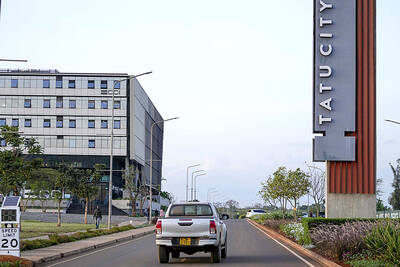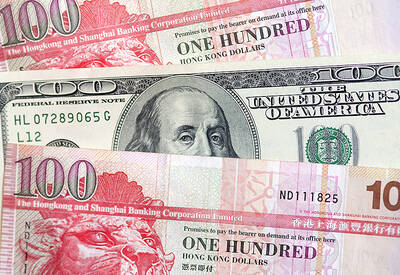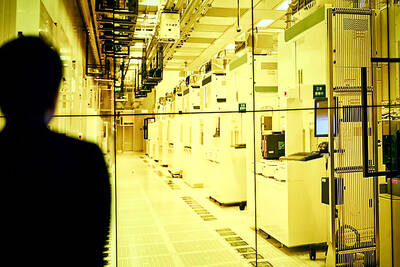It looks like the perfect business opportunity. Every house has one. Everyone uses them. And one Japanese company is making the most technologically advanced products of their kind.
But while the world may beat a path to your door for building a better mousetrap, Toto Ltd has found that selling a better toilet requires more patience.
Toto, the world's dominant maker of high-tech loos, made toilet history in 1980 when, improving on a US model that combined the bidet and the toilet, it produced the "washlet" -- bringing warm water to the user's nether regions.
"We did what others were reluctant to try -- we brought electronics into the water closet," said Hiroshi Kobayashi, Toto's general manager of restroom product research.
Sometimes dubbed "super-thrones," top-of-the-line washlets now come with wall-mounted control panels as sleek and complex as those of stereo systems.
Their manifold buttons allow adjustment of the nozzle position, water pressure and type of spray, plus blow-drying, air purification and seat warming for those cold winter mornings. Water and seat temperatures are adjustable.
The controls can also be set so the lid rises as the toilet is approached.
Japan has embraced the high-tech toilet. Government statistics show that combined toilet/bidets are now installed in 52 percent of Japanese homes compared to just 14 percent in 1992.
Toto -- which employs around 1,500 engineers -- dominates that market with a 65 percent share. Its closest rival, Japan's Inax Corp, trails at 25 percent. Numbers for Japan's overall toilet market share are similar.
But where Sony's Playstation, Toyota Corollas and Pokemon have all blazed paths into western popular culture, Toto's high-tech thrones have not traveled well.
Toto officials blame matters both cultural and practical.
A relatively long history of flush toilets in the US and Europe -- around 100 years -- has resulted in many competitors and cheap toilets.
Westerners just aren't used to shelling out hundreds or even thousands of dollars for high-tech versions.
Most Western bathrooms also lack an electric socket near the toilet, something that people in Japan, where central heating is rare, were keen to install when the seat-warmer was introduced.
But after making some inroads in the US with more standard models, especially with the advent of low-flow toilets in the 1990s, Toto's washlets are starting to make an impression.
Its US washlet sales, which began some eight years ago, have risen to over 1,000 units a month this year from 600 two years ago.
"It's not the same amount of numbers but the trend is very similar to what we saw in Japan 20 years ago -- low figures for about five years and then a sharp J-curve. We have great expectations for US sales next year," Kobayashi said.
But marketing toilets is not easy. Building showrooms is expensive and some analysts estimate it will take another five years before overseas revenues, now only 5 percent of Toto's total sales, climb to 10 percent.
And some cultural barriers seem to be just too hard to break -- witness the European market, where Toto has only one distributor and sells a mere 5,000 washlets annually.
"You'd think that because Europeans are used to the bidet, they'd be more interested. We just don't know why they aren't," said Kobayashi.
Some analysts even argue that tackling cultural norms isn't worth the effort and that Toto would be better off pulling its washlets out of the US and Europe altogether and concentrating on more receptive Asian markets like China.

To many, Tatu City on the outskirts of Nairobi looks like a success. The first city entirely built by a private company to be operational in east Africa, with about 25,000 people living and working there, it accounts for about two-thirds of all foreign investment in Kenya. Its low-tax status has attracted more than 100 businesses including Heineken, coffee brand Dormans, and the biggest call-center and cold-chain transport firms in the region. However, to some local politicians, Tatu City has looked more like a target for extortion. A parade of governors have demanded land worth millions of dollars in exchange

Hong Kong authorities ramped up sales of the local dollar as the greenback’s slide threatened the foreign-exchange peg. The Hong Kong Monetary Authority (HKMA) sold a record HK$60.5 billion (US$7.8 billion) of the city’s currency, according to an alert sent on its Bloomberg page yesterday in Asia, after it tested the upper end of its trading band. That added to the HK$56.1 billion of sales versus the greenback since Friday. The rapid intervention signals efforts from the city’s authorities to limit the local currency’s moves within its HK$7.75 to HK$7.85 per US dollar trading band. Heavy sales of the local dollar by

Taiwan Semiconductor Manufacturing Co’s (TSMC, 台積電) revenue jumped 48 percent last month, underscoring how electronics firms scrambled to acquire essential components before global tariffs took effect. The main chipmaker for Apple Inc and Nvidia Corp reported monthly sales of NT$349.6 billion (US$11.6 billion). That compares with the average analysts’ estimate for a 38 percent rise in second-quarter revenue. US President Donald Trump’s trade war is prompting economists to retool GDP forecasts worldwide, casting doubt over the outlook for everything from iPhone demand to computing and datacenter construction. However, TSMC — a barometer for global tech spending given its central role in the

An Indonesian animated movie is smashing regional box office records and could be set for wider success as it prepares to open beyond the Southeast Asian archipelago’s silver screens. Jumbo — a film based on the adventures of main character, Don, a large orphaned Indonesian boy facing bullying at school — last month became the highest-grossing Southeast Asian animated film, raking in more than US$8 million. Released at the end of March to coincide with the Eid holidays after the Islamic fasting month of Ramadan, the movie has hit 8 million ticket sales, the third-highest in Indonesian cinema history, Film